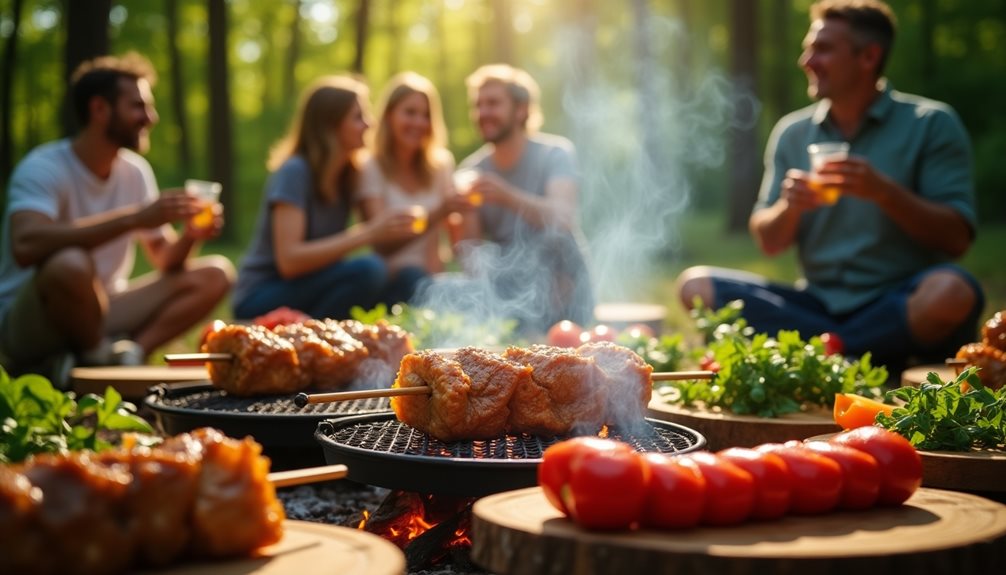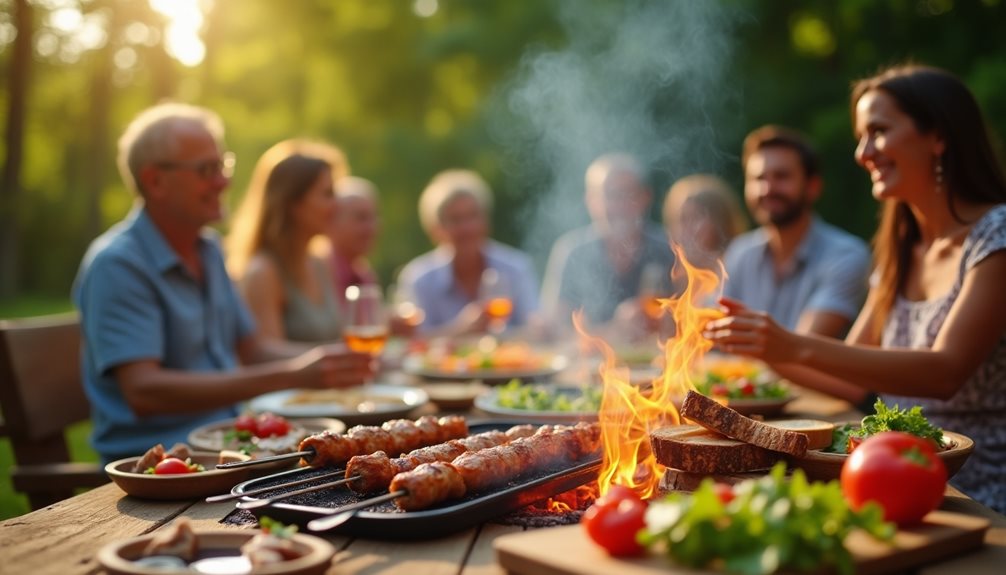Shashlik stands as a culinary embodiment of communal bonding in Russian culture. This skewered meat, often marinated to enhance flavor, serves not only as nourishment but as a catalyst for social interaction. Grilling shashlik transforms mere ingredients into a shared experience, fostering connection among participants. The tradition extends beyond the meal itself, hinting at deeper cultural meanings and practices. Exploring these layers reveals much about the significance of shashlik in both personal and social contexts.
The Art of Preparing Shashlik

Although there are no strict rules governing the preparation of shashlik, the process reflects a blend of tradition and personal flair that defines this beloved dish.
Marinade variations abound, ranging from simple onion, salt, and pepper to more complex mixtures involving kefir or wine. Each unique marinade contributes distinct flavors and textures, showcasing individual creativity.
Grilling techniques also play an essential role, with methods varying from direct heat to slow cooking over coals. This flexibility not only allows for personal expression but also enhances the communal experience, as friends and family gather to share their interpretations of this cultural staple.
Accompaniments That Enhance the Experience
The preparation of shashlik reaches its full potential when accompanied by thoughtfully selected side dishes that enhance both flavor and experience.
Sauce varieties, such as adjika and tkemali, provide a zesty contrast to the smoky meat, while pickled onions add a tangy brightness.
Vegetable pairings, including grilled tomatoes and fresh cucumbers, introduce invigorating notes that balance the richness of the shashlik.
Soft Georgian lavash or crispy baguette serves as the perfect vehicle for savoring these flavors.
Together, these accompaniments create a harmonious dining experience, inviting camaraderie and conversation, integral to the tradition of sharing shashlik among friends and family.
Beverages to Complement Your Shashlik
When considering the ideal beverages to accompany shashlik, one must take into account both traditional preferences and contemporary tastes that enhance the overall dining experience.
Popular drink pairings include robust red wines, particularly favored in southern regions, and invigorating beers that suit casual gatherings.
For winter occasions, vodka or cognac complements the smoky flavors beautifully.
Non-alcoholic options like seasonal beverages—compotes or teas—also cater to designated drivers and those opting for lighter fare.
Ultimately, the choice of drink can elevate the communal essence of shashlik, reflecting the diverse palettes of those gathered around the grill.
Cultural Significance

Shashlik serves not only as a beloved culinary tradition but also as a cultural cornerstone in Russian society, embodying values of community, relaxation, and the art of socializing.
Central to family gatherings and seasonal celebrations, the act of grilling shashlik fosters connections among friends and loved ones, creating lasting memories. This tradition encourages individuals to pause life’s rush, engaging in meaningful conversations around the fire.
Shashlik transcends mere sustenance, symbolizing a collective identity and shared experiences, reflective of the Russian spirit. Ultimately, it reinforces the importance of togetherness, enhancing social bonds that define contemporary Russian culture.
Shashlik Around the World
While culinary traditions vary widely across cultures, the concept of grilling meat over an open flame resonates universally, showcasing a shared human desire for communal dining experiences.
In Turkey, Shish Kebab features marinated chunks of meat, often served with rice and vegetables, creating a social atmosphere similar to shashlik.
Meanwhile, Korean Samgyeopsal emphasizes grilling pork belly at the table, encouraging diners to wrap meat in fresh greens, highlighting the interactive element of shared meals.
Each tradition, while distinct, reflects a profound cultural appreciation for togetherness, illustrating how grilling transcends borders and fosters connections among people worldwide.




